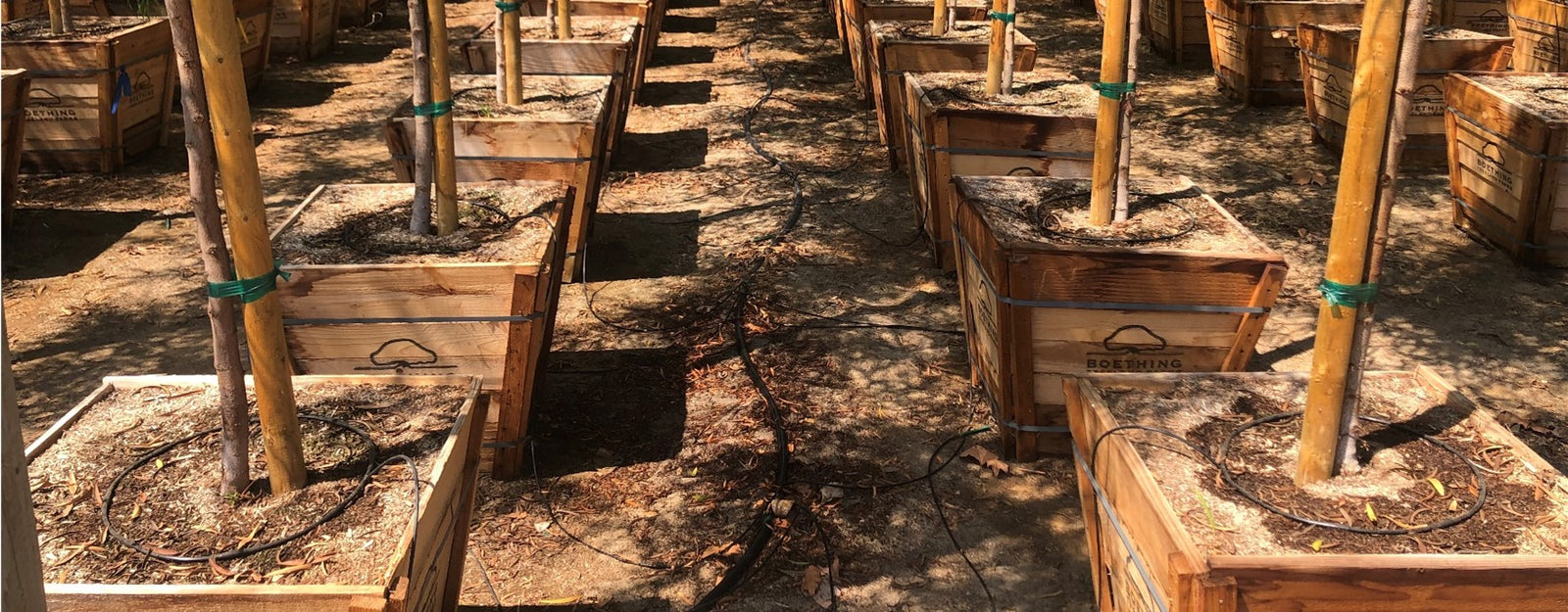Introducing the Primerus Pot-Dripper Drip Ring

Irrigating large containers is challenging. This is specially true with crops such as cannabis which need all variables carefully controlled. Sprinkler irrigation is a no-go because it wets foliage and sends the majority of water outside of the container. Drip is difficult because, with light media, only the area under the dripper is wetted while the rest of the root zone stays dry. Spray stakes address both of these concerns, but can still overspray outside of the container and they keep the plant’s trunk wet during irrigation. The Primerus Pot-Dripper solves all of these problems: uniform irrigation at a controlled rate throughout the entire container, zero overspray, zero trunk and foliage wetting.
The Pot-Dripper system is comprised of a ring of clog resistant ¼” Drip Emitter Line in each container supplied by an innovative Primerus Pot-Dripper stake. The ring diameter can range from 5.75” to 19” to fit your container and deliver the right amount of water. Broad distribution of water means healthy root development and Drip means zero overspray. Each Pot-Dripper can operate as a simple non-compensating device, or it can be combined with a PC “Hub Emitter”, giving it all of the features of a Compensating Non-Leak (“CNL”) device.

Primerus Pot-Dripper Stake
Drip rings have been used for years by quality-conscious growers on high value container crops. The earliest drip rings were “home-made” versions using a ¼” barbed Tee and a ring of ¼” dripline. While very effective, they had the disadvantages of requiring an anchor to keep them stable in media, and needing to be cut (and destroyed) to remove the ring from the container. In the past several years several commercial versions have become available such as the Netafim NetBow and the Hydro Flow Rain Ring, which lack the flexibility and features of the Pot-Dripper and in some cases are expensive. The Pot-Dripper provides the best overall package of functionality and price for precision container irrigation.
Important and unique features of the Pot-Dripper Drip Ring include:
- High quality, clog resistant drippers, one dripper per 2-inches of diameter
- Ability to use non-compensating or as a Compensating Non-Leak (CNL) device
- Long, 8” stake to securely anchor in the media
- Easily removed from plant, regardless of trunk diameter
- Shut-off feature to turn flow off when a container is removed from service
- Low cost compatible with large growing operations
How to Select a Pot-Dripper
You can use the Pot-Dripper as a simple non-compensating device or combine it with a Hub Emitter for pressure compensating CNL operation. Conventional nursery and tree farms tend to favor the non-compensating configuration, while cannabis growers usually opt for a hub emitter because the CNL feature lends itself to high frequency irrigation.
Without a Hub Emitter, the flow rate of each Pot-Dripper is determined by the tubing ring diameter as shown in Table 1. Larger rings deliver more water. When used with a Hub Emitter the flow of each Pot-Dripper ring is set by the hub emitter.
Simply choose a ring diameter that’s right for your container using the Table 1. If you choose to use a hub emitter, select the right one from the same table. Hub emitter part numbers are in Table 2.

Table 1
Note that you can either buy Pot-Drippers fully assembled from Grow Irrigation, or you can buy the ¼-in dripline and Pot-Dripper Stake separately from Grow and assemble your own. Grow stocks 10” and 12” diameter fully assembled Pot-Dripper rings. If you assemble your own you can build any diameter from 5.75” to 19”.

Table 2
How Use the Pot-Dripper

Insert the stake into your container media so the ring encircles the plant. If the plant is already established, you can pull one end of the tubing ring off the stake, bring it around the plant then reseat it.

Feeder Tube Ends, With and Without Hub Dripper


Insert Feeder Tube into Supply Lateral
If you are using a Hub Emitter, instead cut the starting end of the 1/8” tube at 90°, place it on the output barb of the Hub Emitter, and insert the Hub Emitter into the hole you have punched in the lateral. Only one hub emitter barb is the right size to fit the spaghetti tube, so you can’t make a mistake.
You are now ready to irrigate. Keep supply pressure at 15 psi for non-compensating operation or between 15 and 50 psi if using a Hub Emitter. See the Primerus Pot-Dripper Instructions for Installation and Use for more detailed information.
Control Your Irrigation
Using the Pot-Dripper you can adjust your irrigation schedule to give your plants the exact amount of water they need. Using a hub dripper, you can be confident that all containers receive the same amount of water and nutrients. The hub dripper also prevents draining of the laterals to the low point in each row, meaning you can uniformly irrigate many times per day. When properly managed, the Pot-Dripper will deliver the optimum root zone environment to your plants, resulting in better quality and higher yields.


